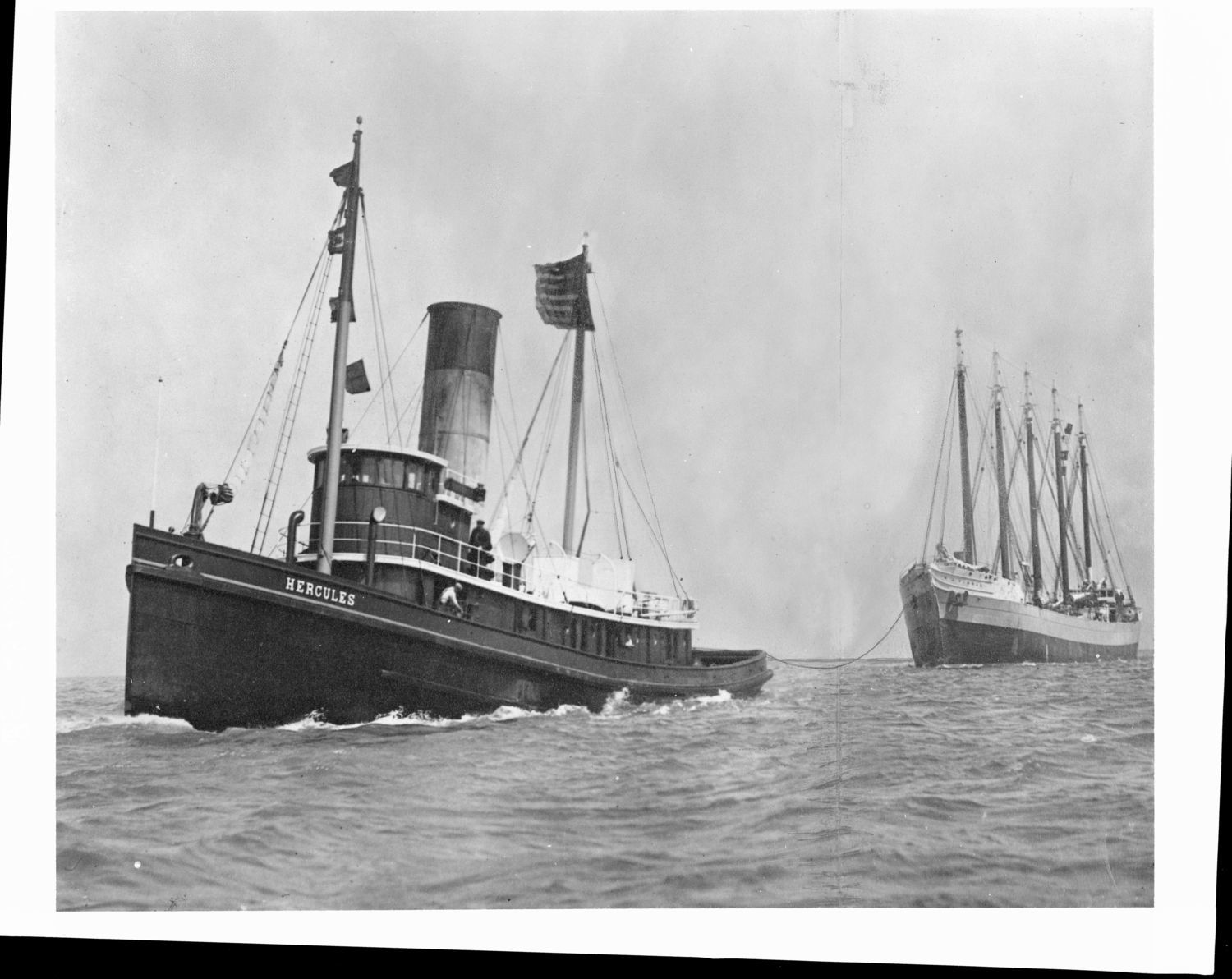Last updated: August 15, 2025
Lesson Plan
Inside the Engine Room - Hercules STEAM Unit Lesson 6

Hercules at sea (ca. 1910) towing W.J. PIERRIE (built 1883; schooner, 5m).
SAFR 21374
- Grade Level:
- Upper Elementary: Third Grade through Fifth Grade
- Subject:
- Science
- Lesson Duration:
- 60 Minutes
- Common Core Standards:
- 4.SL.1
- State Standards:
- CA 4-PS3-2: Make observations to provide evidence that energy can be transferred from place to place by sound, light, heat, and electric currents.
CA 4-PS3-3: Ask questions and predict outcomes about changes in energy that occur when objects collide. - Thinking Skills:
- Understanding: Understand the main idea of material heard, viewed, or read. Interpret or summarize the ideas in own words. Analyzing: Break down a concept or idea into parts and show the relationships among the parts. Evaluating: Make informed judgements about the value of ideas or materials. Use standards and criteria to support opinions and views.
Essential Question
What is the transfer of energy in the engine room? How does steam generate motion?
Objective
Students will be able to infer how energy is transferred in the engine room.
Background
Steam from the boiler room travels to the engine room. The valves move down, allowing steam into the cylinder. Inside the cylinder, there is high pressure and low volume. The high pressure of the steam pushes the pistons down. The volume increases when the pistons are pushed down. When pistons push down, the crankshaft rotates, thus spinning the propeller. The propeller powers the tugboat.
Note: the in-class experiment involves the use of open flame and steam. Please use all necessary precautions or consider showing this video demonstrating air pressure: Build a Balloon Car | STEM Activity.
Steam pressure is more effective than air pressure because it carries more latent energy through the heat needed to convert water to steam.
Preparation
- Print worksheets.
- Set up experiment
- Download TimeLooper XPlore app (if not already downloaded) and test.
Materials
Instructions, materials, and safety notices for balloon rocket demonstration.
Download Balloon Rocket Demonstration
Slides for classroom discussion and demonstration
Download Day 6 Classroom Slides
Worksheets & graphic organizers for observations and inferences.
Lesson Hook/Preview
Hercules' boiler converts water to steam using oil and heat, but how does steam make the ship move?
Procedure
- Revisit Engine Room in San Francisco Maritime Time Looper Xplore App: replay video.
- Classroom Share: what did you observe? What questions do you still have?
- Show picture of engine system and link to balloon experiment.
- Demonstrate for students. See demonstration worksheet for instructions. Students take notes and draw observations.
- Classroom Share: What did you observe? What do you think is happening?
- Connect balloon experiment to Hercules' engine. Introduce the concept of pressure and show students the pHet simulation at Energy Forms and Changes. Use the kettle and propeller for the most similar comparison to Hercules' engine system. Have students take notes and draw observations. Use slides to closely observe and guide students to determine how the engine functions.
- Compare and contrast: Ask students to closely observe what happens in the engine and explair how aire moves it. How is this similar to the balloon experiment? How is it different?
- Knowledge check: Have students demonstrate the transfer of mechanic energy by drawing arrows to show the cause and effect relationships in the engine room. Allow them to fill out Cause & Effect graphic organizer. Review responses as a class.
- Exit ticket: What is the transfer of energy in the engine room?
Vocabulary
- Pressure: a force on an object
- Energy: what makes things change and move. It can be stored in things. It's all around us!
- Chemical energy: energy that is stored in chemicals and is involved in reactions
- Heat (thermal) energy: energy in the form of heat
- Mechanical (motion) energy: energy in the form of movement
Assessment Materials
Exit TicketStudents will fill out this exit ticket as a class to demonstrate their understanding of the Hercules engine system
Hercules Day 6 Exit Ticket
Supports for Struggling Learners
- Review vocabulary beforehand (included in powerpoint).
- Strategically partner students so that they are provided with additional supports.
- Sentences frames (included in powerpoint).
Enrichment Activities
Students write their own diary entry from the perspective of someone who worked in the engine room.
Related Lessons or Education Materials
This is lesson 6 of the Hercules STEAM unit.
